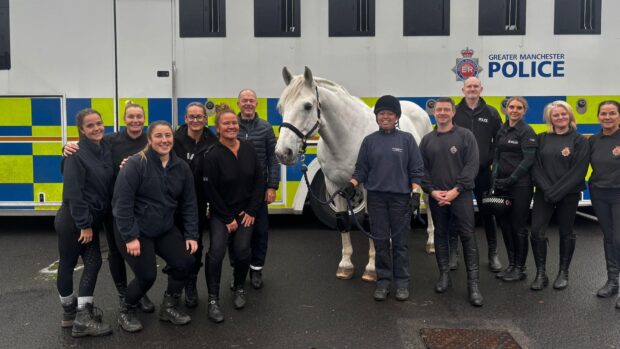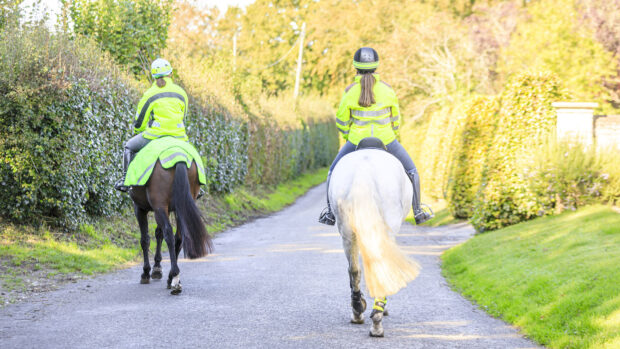Groundwork exercises can help address anxious behaviour for spooky horses, whatever your horse’s age or stage of training. We asked horse behaviour specialist Kelly Marks for some simple techniques that you can practise to build your horse’s confidence and trust. Kelly is the founder of Intelligent Horsemanship and has toured the world “helping horses and humans to have happier relationships”.
Some horses are born far spookier than others, as Kelly explains: “If you suddenly open an umbrella five yards away, you’d expect the average horse to spook about three strides, then come back and look at it, while a truly spooky horse will be gone in a second. But the most challenging horses to work with are those that ‘front up’ and look as if they’re on the attack.”
When it comes to groundwork exercises for spooky horses, Kelly practises “acceptance training” rather than “desensitisation”.
“You don’t want a horse to ignore its surroundings; they need to stay alert without feeling stressed,” she explains, adding, “The advantage of groundwork over ridden work is that you can watch and listen carefully to what’s going on with the horse.”
Begin by ruling out common causes of spooking, such as incorrect feeding, too little exercise, a lack of pasture time, or limited exposure to a “normal” environment.
Kelly advises, “You also need to check that the horse doesn’t have any health issues because pain can make a horse spookier.”
Above all, Kelly warns against punishing a spooky horse: “Imagine being scared of something and then someone inflicts pain on you. It just makes everything worse.”
What kit do I need?
Kelly uses a Dually halter, which has a sliding noseband that avoids damaging the horse’s mouth, sensitive areas of the face, or poll. Alternatively, you could use a well-fitting head collar or rope halter.
Whatever your choice of halter, Kelly recommends attaching a 20-foot line or rope to reduce the risk of injury if your horse spooks off.
Groundwork exercises for spooky horses
Exercise 1: backing up
Aim: Kelly explains that backing up enables the horse to concentrate, listen, and give you space, as well as calming them down before you begin work.
“This exercise is the foundation on which to build everything else,” she says. “It helps the horse physically, mentally and emotionally – and most horses will find it easy.”
However, she warns, “If the horse finds it difficult to step back, and you’re confident you’re doing the exercise correctly, get them checked by a vet.”
- In a stable or safe, enclosed area, stand facing your horse and slightly to one side.
- Then ask the horse to step back by applying light pressure on the line or by using your fingertips on their chest. You may like to add a verbal cue such as saying back or make a specific noise that you don’t use at any other time.
- Release the pressure as soon as the horse takes one step back, then give them a moment to process what they’ve learnt.
- Repeat the pressure and release, one step at a time, giving the horse plenty of time to process this during the early stages.
- Begin this exercise with just one step back on the first day, then build up gradually to 10 steps, with the horse’s head slightly lowered, over time.
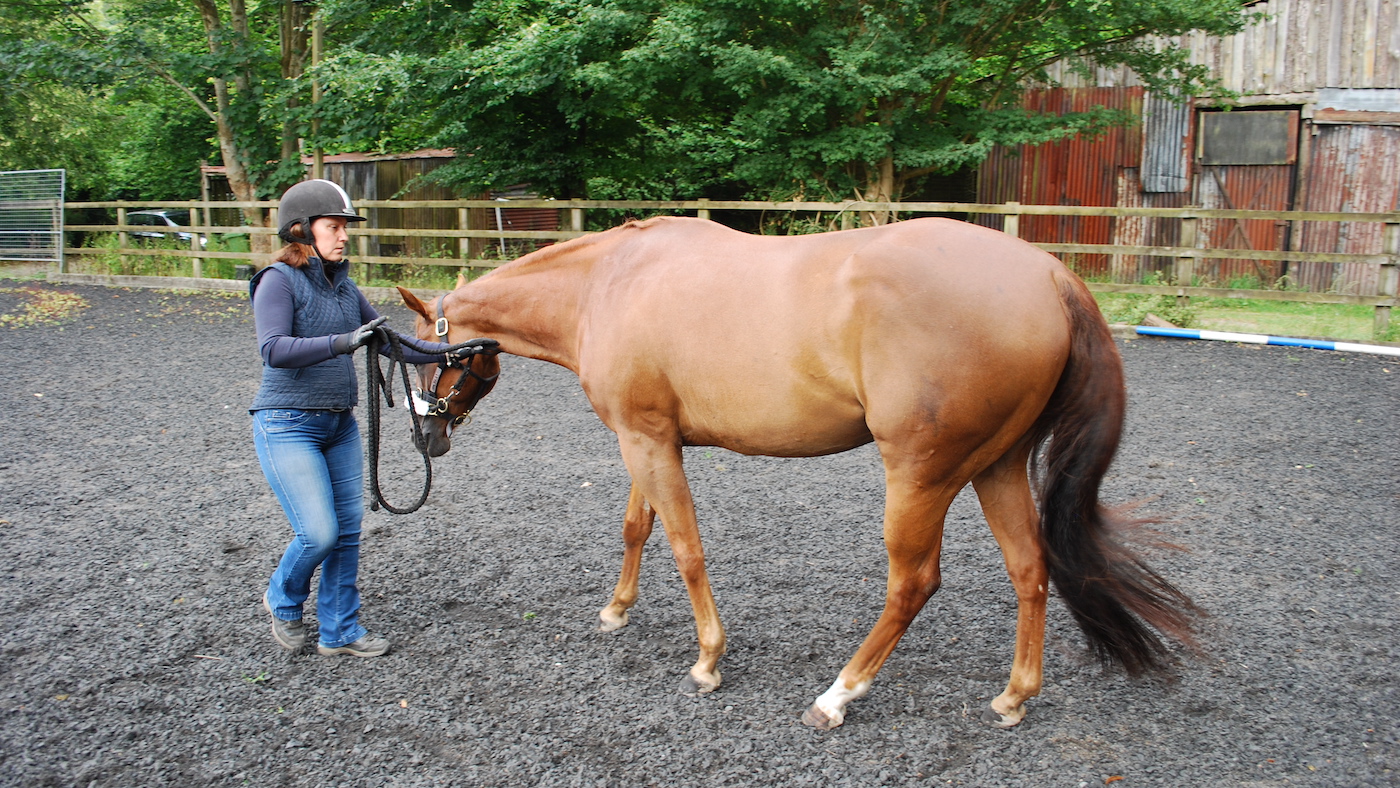
Backing up a horse is the foundation – it helps calm horses down before you begin work. Credit: intelligenthorsemanship.co.uk
Exercise 2: head lowering
Aim: lowering a horse’s head can reduce the heart rate, helping them to relax. Kelly advises practising this exercise regularly, beginning in the stable.
“It’s a bit like a human taking a deep breath,” she explains. “It calms them down before or during work.”
Put on the halter and lead rope, then apply gentle, steady, or slightly pulsing pressure on the rope, releasing immediately when the horse responds by lowering the head.
“This teaches the horse that if you put the slightest downward pressure on the line, you’re asking them to lower their head and relax,” says Kelly.
“Be calm and consistent. It might take a few minutes the first time, but most horses get it within three attempts.”
Once this technique has been established in the stable, you should practise the exercise in other familiar places for your horse such as your arena, before trying to use it in more challenging situations, such as out at shows.
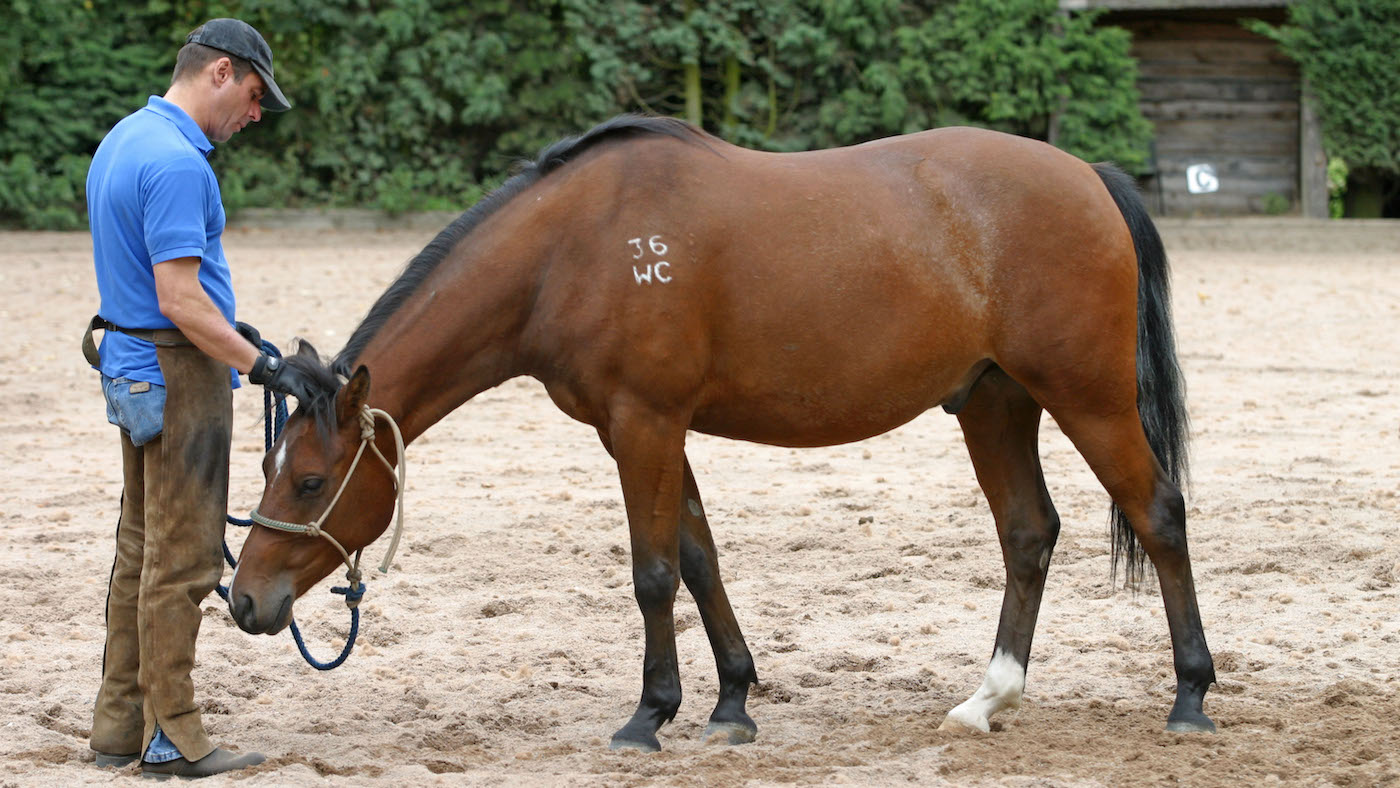
When the horse lowers his head and he relaxes there, his heart rate slows, helping him feel more relaxed. Credit: Alamy
Exercise 3: acceptance training
Aim: use this exercise to address issues with an all-round spooky horse or with an obstacle you’ve found particularly challenging, such as a tarpaulin or dustbin.
1. Find a safe, well-fenced area and wear a hard hat, gloves and suitable footwear. Never wrap the line around your hand.
“It’s important to find a time when you’re feeling calm and relaxed but alert – and remember to breathe!” advises Kelly.
2. “Lead the horse calmly, keeping yourself between the obstacle and the horse so that, if they shy away from the obstacle, you stay safe.
3. “Gradually let out the line and begin by circling the object rather than approaching it directly.”
It’s important to monitor the horse carefully for signs of stress or acceptance during this process to ensure positive associations are built.
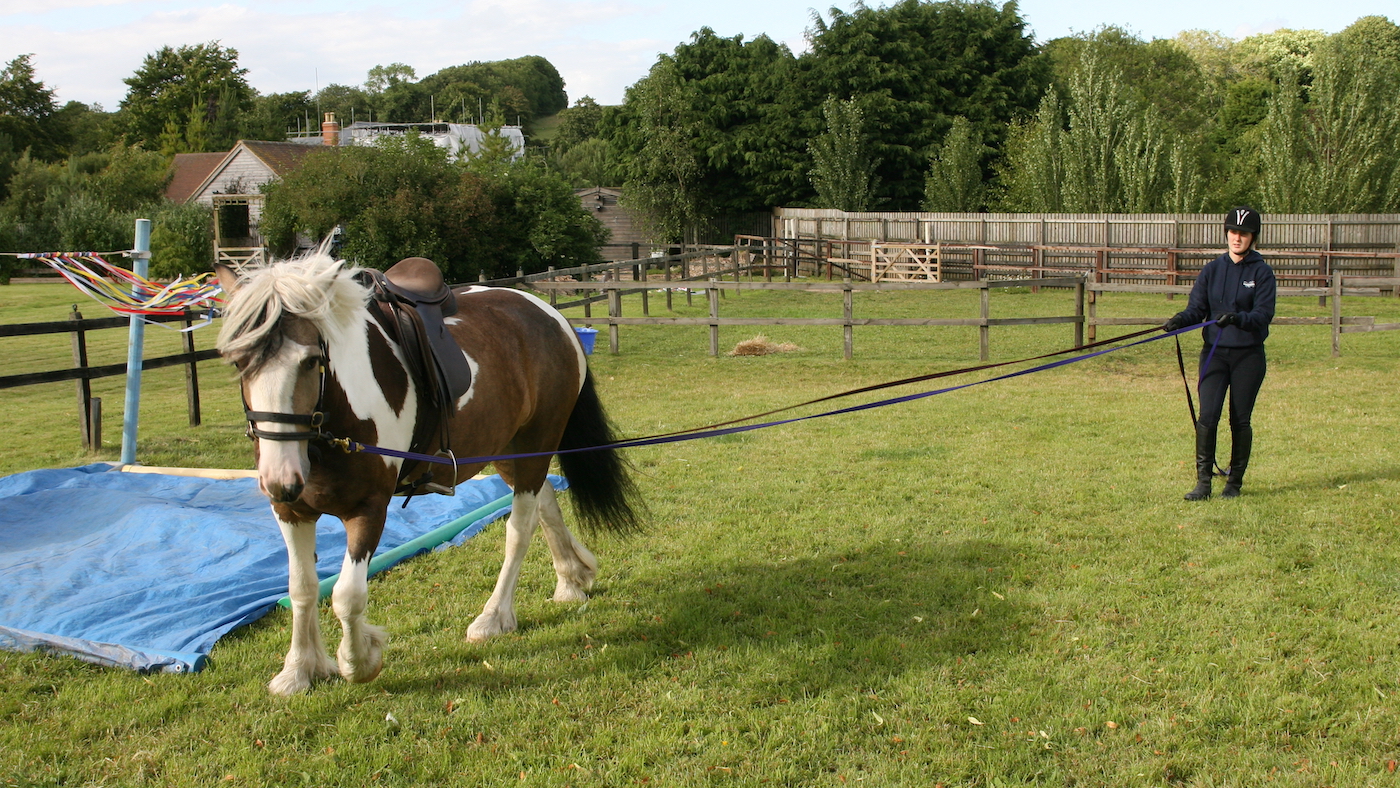
Begin by circling near the spooky object, such as a tarpaulin, rather than approaching it directly. In this example the horse is being long-lined rather than led. Credit: Intelligenthorsemanship.co.uk
4. Kelly adds: “Over a period of time, you can help your horse to ‘accidentally’ touch the spooky object.
5. “Build on this over several sessions until the horse can walk over or past the obstacle calmly. Sometimes, just allowing a horse to touch a ‘scary’ object with their nose can help them gain confidence, but don’t try to force this.”
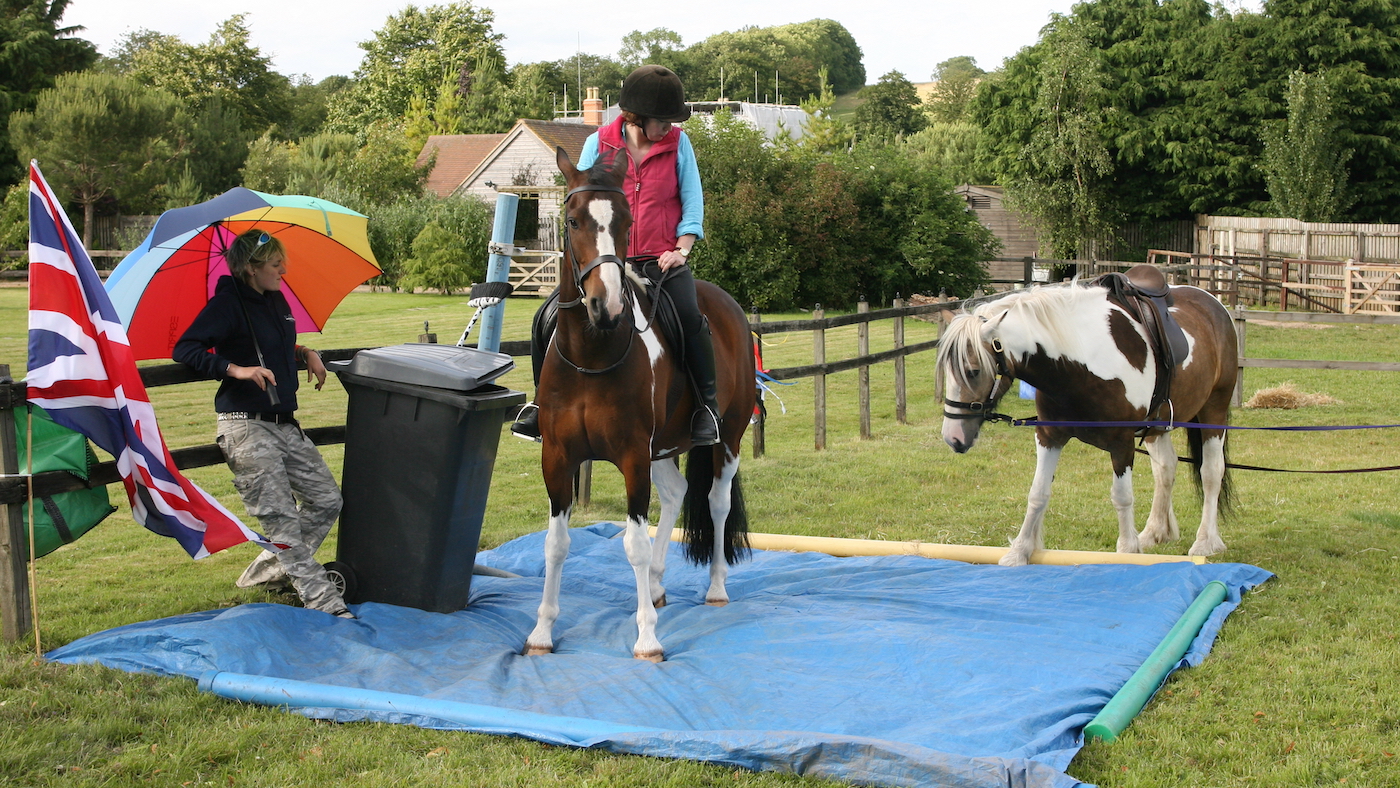
Kelly Marks demonstrates training a horse to accept an extremely spooky situation. Credit: Intelligenthorsemanship.co.uk
Using another horse as support or food as a reward can also help.
Kelly suggests: “Just leaving hay or pony nuts on or around an obstacle can take away the pressure and will reward the horse for being brave.”
However, Kelly warns, “If a horse is frightened, never punish them or insist they approach it directly. And, above all, make sure you keep yourself safe.”
Contact Kelly Marks for more information or advice.
Did you find this article helpful? You may also like to read…

Is your horse too sharp to ride? Try these three-minute groundwork exercises to take off the edge and engage their brain before you get on

‘A broader experience of life off the leadrope’: Emma Massingale reveals the liberty training exercises you need to start your journey

Groundwork for horses: what it is and why it’s useful

‘Be the catalyst for fun in your horse’s life’: Emma Massingale’s expert tips to get a horse to tune in and listen to you

‘The more time you “waste”, the better your relationship’: how less is more for Olympic ‘mare of all mares’

Subscribe to Horse & Hound magazine today – and enjoy unlimited website access all year round


